Circuits and Oscillations
1/29
There's no tags or description
Looks like no tags are added yet.
Name | Mastery | Learn | Test | Matching | Spaced |
|---|
No study sessions yet.
30 Terms
what are neurones in circuits?
Although neurones are (mostly) discrete and independent, they do not act in isolation
“Neuropil” – dense tangle of axons, dendrites and glial processes
Vital for organisation and information processing
Circuits are complex & coherent; although diverse, show many commonalities
what is the correlation between odd and even number of inhibitory pathways?
odd number of inhibitory pathways= inhibition
even number of inhibitory pathways= excitation
what is convergence: coincidence detection?
Activation of 1 or 2 alone insufficient to activate output neurone
Activation of 1 AND 2 however will activate output neurone
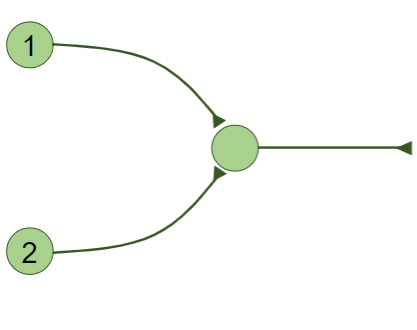
what is a reverberating circuit?
Pathway of excitation with positive feedback such that activity continues throughout the network; stays on until switched off.

what type of circuit is respiration?
reverberating circuit
Central pattern generator
Sensory feedback from lungs of extension “switches off” pro-inspiration drive
Reverberating circuits maintain sustained AP generation or absence in neurones controlling diaphragm
what is parallel after-discharge?
Single input leads to prolonged output (up to ~15ms). Thought to be involved in complex conscious thinking.

what is disinhibition?
usually an inhibitory cell is tonically active; must be suppressed to facilitate activation of the output neurones.

what are examples of topographical representations?
whiskers
layer IV barrel cortex
cortical columns

what is the hippocampus and memory?
Lesion experiments suggest CA1 is most vital area for memory formation
Processing of data via convergence / divergence in DG and CA3; encoding of memory and outputs from CA1
Major role for synaptic plasticity: strengthening of synapses to “store” information
what is the thalamocortical circuit?
Thalamocortical connections topographic
Dorsal thalamus excites CTX; CTX output excites thalamus
Feedback inhibition via GABAergic reticular thalamic neurones
Basis of oscillatory activity

what are the basal ganglia pathways?
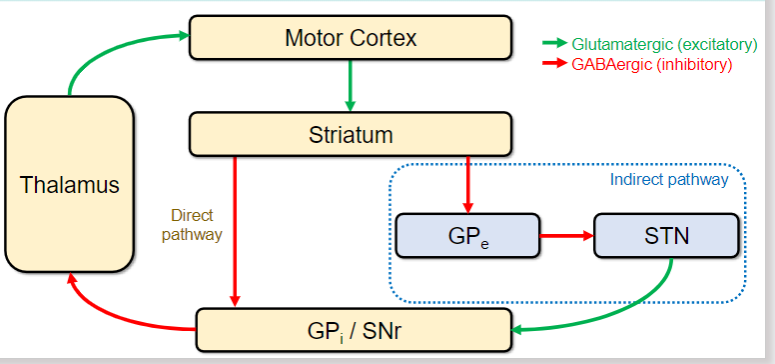
what is direct and indirect pathway activation?
Pallidal (GP) cells are GABAergic and tonically active.
Basal ganglia is inhibitory: acts to suppress excitatory feedback between thalamus and cortex
Direct pathway activation decreases this inhibition: “Disinhibition”
i.e. increases corticothalamic excitation
Indirect pathway activation increases this inhibition
i.e. decreases corticothalamic excitation
what is electroencephalography?
Measures the general activity of the brain
Generally non-invasive and painless
Useful for examining neurological states (e.g. sleep) and diagnosing pathologies (e.g.
epilepsy)
what are EEG neurones?
Afferent signals activate synapses and open cation channels
Positive charge enters the dendrites; the extracellular space around the dendrites becomes negative. This can be measured by a scalp electrode

what are the conclusions on EEG?
Good temporal resolution
Decent spatial resolution
Non-invasive for cortical layers, but need implanted electrodes (very invasive!) for deeper brain areas.
what is ECoG?
a.k.a. intracranial electroencephalography (iEEG)
Similar to EEG but:
• Invasive
• Greater precision & sensitivity
• Can be used in epilepsy diagnosis

what is MEG?
magnetooencephalography
Similar in ways to EEG:
Recorded by magnetic field sensors over skull
Good temporal and decent spatial resolution
Receive similar sort of waveform data
Non-invasive
Not feasible on cerebellum, difficult with deeper brain areas
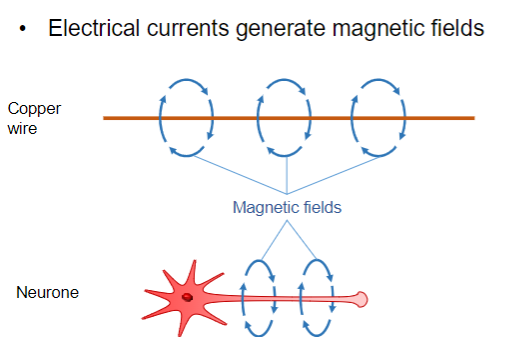
what is fMRI/PET?
NOT suitable for measuring oscillations; low temporal resolution
Measure changes in blood flow (fMRI) or metabolism (PET)
Provide evidence of brain activity:
Research (correlate brain activity to tasks)
Clinical (e.g. dementia & cancer diagnosis)
What is functional magnetic resonance imaging?
Magnetic signals measure blood flow associated with neuronal activity (oxygenated / non-oxygenated)
Good penetration (can see deep into brain)
Good spatial resolution
Poor temporal resolution (>1s):
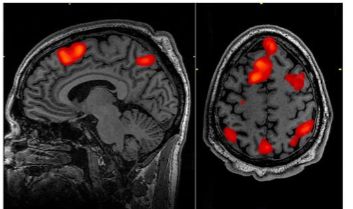
what is positron-emission tomography?
Uses radiotracers – usually glucose derivatives – to examine brain metabolic activity (invasive)
• High penetration
• Good spatial resolution
• Very poor temporal resolution

what are oscillation types and functions?
Although oscillations associated with certain states, many brain areas are distinct and have specific forms of brain rhythm.
Infra-slow, slow, delta, alpha, theta, beta, gamma
Lower frequency oscillations tend to be much stronger (i.e. involve many more neurones) than higher frequency
what types of activity are brain oscillations associated with?
Beta: Mind and body active; short term memory activity
Alpha: Relaxation; long-term memory; learning
Theta: Deep relaxation; creativity; subconscious access
Delta: Sleep; minimal brain activity
what are Beta and Gamma oscillations?
Low beta frequencies associated with activity & readiness, being busy, active thinking, anxious thinking
Gamma oscillations frequently weak; relatively small number of neurones involved
Usually very brief (few seconds)
Associated with high activity; concentration, fear, consciousness, problem solving
Interaction of gamma with other rhythms
what are slow oscillations?
Periods of successive depolarisation (“up” states) and hyperpolarisation (“down” states), ~ 0.1-0.5 Hz.
Up states associated with burst firing of neurones
Generated in cortex (present if cortical inputs severed); absent in thalamus if decorticated
Highly prevalent in sleep and types of anaesthesia
what are the origins of oscillations?
Intrinsic activity: Intrinsic cell currents – “pacemakers”
Extrinsic activity:
Most neuronal activity driven; i.e. input-dependent
Local oscillations; co-ordinated by local connections
Area-area oscillations, e.g. thalamocortical loop
what are pacemaker currents?
Complex interplay of intrinsic cell currents
Wide range of K+ currents active at different voltages; probably most important ion for intrinsic rhythmic activity
Modulation by synaptic input; direct excitation, inhibition, modulation
what is excitation driven network?
Hard to effectively couple neurones in a network
Capable of slow rhythms (theta) experimentally, but non-physiological
Excitation normally associated with antiphase

what are interneurones?
GABAergic neurones allow for better co-ordination of cells
Excitation; activated neurones and interneurones
Interneurones activate and then suppress excitatory neurones
Interneurones also lose excitation; excitatory cells fire again
Especially notable for gamma
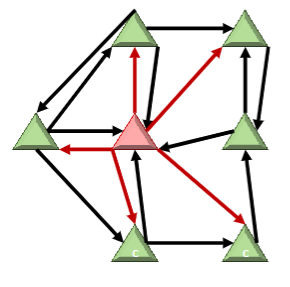
what is the thalamocortical loop?
Network driven by feedback and feedforward mechanisms
Again interplay of excitatory and inhibitory interactions
Involves both local activity and between brain regions
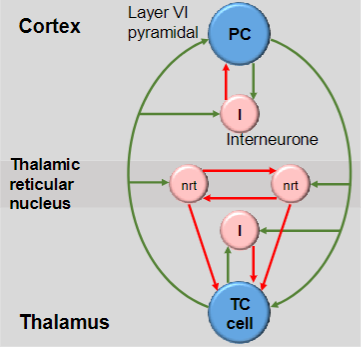
what is the function of oscillations?
Although oscillations are observed to be associated with forms of brain activity, oscillations are not yet proven to be necessary for brain function.
Various theories for the use of oscillations
Computational modelling predicts usefulness